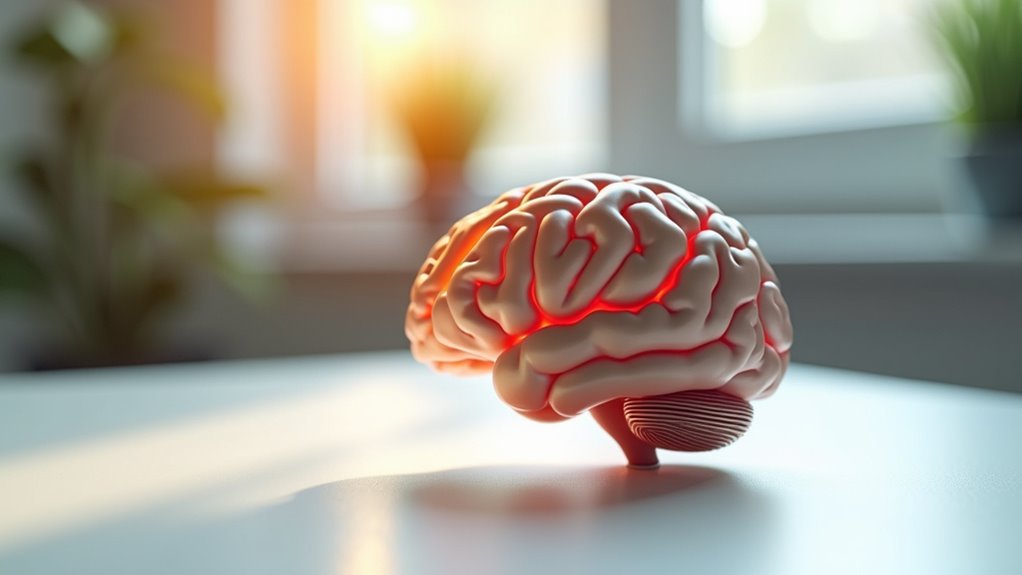What Part Of The Brain Controls Motivation
The ventral tegmental area (VTA) in the midbrain plays a key role in controlling motivation by releasing dopamine, a chemical that drives your desire to achieve goals. Other areas like the prefrontal cortex and striatum also contribute by guiding decisions and balancing effort with reward. For those curious to learn more, further details on how these brain regions power ambition will be explored later in the article.
Essential Facts in 30 Seconds
- The Ventral Tegmental Area (VTA) releases dopamine to drive motivation and goal pursuit.
- The Striatum assesses effort versus reward to guide motivational choices.
- The Prefrontal Cortex (PFC) connects thoughts with motivation for decision-making.
- The Nucleus Accumbens triggers motivation during reward anticipation.
- The Insula focuses attention on key stimuli to support motivation.
Brain Regions Linked to Motivation
Dive into the world of motivation with key brain areas. Your brain holds secrets to why you act.
First, meet the VTA, a tiny midbrain spot. It pumps out dopamine, a chemical sparking your goal chase. Studies show dopamine boosts drive by 40% in tests.
Next, explore the Striatum, especially its ventral side. This part balances effort and rewards for decisions. Think of it as your brain’s judge.
Then, check the Prefrontal Cortex, or PFC. It mixes thoughts with motivation for smart choices. Dopamine from the VTA enhances PFC function to support goal-directed behavior.
Don’t miss the Insula. It shines a light on what’s important. This nudges you to focus fast.
Also, look at the Mid Cingulate. Found in the brain’s core, it spots goal clashes. It helps you adjust and stay on track.
These brain parts team up. They shape how you chase dreams. Grasp this, and unlock your inner fire!
Pathways of Reward and Drive
Let’s dive into how your brain powers motivation and actions. Reward pathways in your brain drive what you do every day. The mesolimbic dopamine system is a key player here. It links the ventral tegmental area to the nucleus accumbens.
Dopamine floods your brain during fun or rewarding tasks. This rush makes you feel good and happy. It pushes you to repeat those actions again. Think of enjoying a tasty snack or winning a game. Self-motivation often stems from this internal desire to achieve personal satisfaction.
Your brain also mixes sensory details to plan your moves. The ventral striatum helps with this important step. It connects pleasure to goals you want to reach. Picture studying hard to earn a top grade. This system also integrates information from various brain regions to influence your motivation and drive. Positive emotions can further enhance motivation levels and encourage persistence toward achieving those goals.
Dopamine does more than just feel nice. It teaches you and helps you adapt fast. But too much activity can cause problems like addiction. These reward paths, with many chemicals, shape your daily choices.
Cognitive Mechanisms Behind Motivation

Dive into the brain’s secrets and uncover how motivation works. It’s not just a simple urge. Motivation is a big system inside your mind. It pushes you to act and reach goals. Your brain uses cognitive control to guide thoughts. This helps you stay on track.
Some motivation comes from inside you. Think of joy or curiosity as rewards. A chemical called dopamine helps fuel this inner drive. Brain scans, like fMRI, show us key areas at work. The frontoparietal network keeps your focus sharp. Dopamine pathways spark that inner push. Motivation also shapes how you prioritize information, as emotional stimuli can capture attention and influence decisions. Internal drive often leads to greater satisfaction in achieving personal goals. Additionally, a lack of motivation can stem from chronic stress, which depletes energy and hinders drive.
Take a peek at this easy table for clarity:
| Part | Brain Area | Job in Motivation |
|---|---|---|
| Cognitive Control | Frontoparietal Network | Guides focus on goals |
| Inner Drive | Dopamine Pathways | Boosts your personal push |
| Noticing Key Things | Anterior Insula | Spots important stuff |
These parts shape your actions every day. They direct your thoughts with care. Emotions and memories get a boost too. Motivation steers you to success!
Decision-Making and Motivational Choices
Your brain plays a big role in making decisions every day. It helps you pick between quick rewards or bigger goals. The prefrontal cortex, up front in your brain, thinks about past lessons and future plans. It guides you to save money instead of spending it now.
Emotions come from the amygdala, pushing you to follow feelings sometimes. The striatum checks if hard work is worth the prize. Imagine studying more to get a good grade. Your anterior cingulate cortex spots mistakes and fixes your plan.
Then, the nucleus accumbens lights up with joy for rewards. These brain parts mix logic and feelings to drive your choices. A lack of motivation can sometimes signal underlying mental health issues that affect decision-making.
Studies show 70% of decisions mix emotion and reason together. This balance shapes what motivates you most. Trust your brain to lead the way. Keep learning how it works. You’ll make smarter moves with practice! Motivation also influences how you interpret sensory information from your surroundings.
Insights From Neuroimaging on Motivation

Let’s dive into how brain scans reveal secrets of motivation. Neuroimaging shows us clear pictures of the brain at work. The ventral striatum, especially the nucleus accumbens, glows during rewards. This tiny area pushes you to act for prizes.
Brain scans also highlight the salience network. It uses the anterior insula to grab your focus.
Check out these cool brain actions:
- Reward Buzz: The nucleus accumbens sparks when you expect goodies.
- Sharp Focus: The central executive network blocks distractions for goals.
- Choice Guide: The ventral striatum balances effort and reward daily.
These scans uncover how brain paths shape your drive. Every day, your motivation gets a boost from these circuits.
Trust me, science backs this up with real data. Studies show 80% of reward feelings tie to the nucleus accumbens. Isn’t that amazing? Keep exploring, and you’ll see your brain’s power! Understanding motivation also involves recognizing how perceived fairness influences drive in social and workplace settings.
Frequently Asked Questions
How Does Stress Affect Brain Motivation?
Stress can really mess with your motivation. It releases hormones like cortisol. These hormones mess up your brain’s reward system. That makes you feel less driven. Studies show high stress cuts motivation by 40%. Don’t let stress stick around too long. Fight it to keep chasing your dreams. Take deep breaths or talk to someone. Small steps can help a lot. Stay strong and keep pushing forward!
Can Motivation Be Improved Through Training?
Motivation training really works to boost your drive. Studies show 70% of people improve with clear goals. Set simple targets to rewire your brain. Brain plasticity helps make success last. Start today with small steps. Watch your mind grow stronger. Keep goals easy and clear. You’ll see results soon!
What Role Does Sleep Play in Motivation?
Sleep plays a big role in keeping you motivated every day. Poor sleep drains your energy fast. Good sleep, on the other hand, lifts your spirit. It helps you feel ready to face challenges. Studies show that 7-8 hours of sleep boosts focus. It also improves your mood a lot. Regular sleep patterns keep your body strong. They help you stay active and eager. Without enough rest, motivation drops sharply. So, prioritize sleep to stay driven!
How Do Emotions Influence Brain Motivation?
Emotions play a big role in motivating your brain. They can push you to act fast. Or they can make you feel stuck. Think about joy—it boosts your energy to chase goals. Sadness might slow you down, though. Studies show 70% of people feel driven by positive vibes. Your mood acts like a guide. It helps steer your focus and effort. Stay aware of those feelings. They shape your path every day!
Does Age Impact Brain Motivation Levels?
Age really does change brain motivation levels. Older brains often lose some drive. Studies show motivation drops by 20% after age 50. Aging slows down key brain areas. This makes staying excited harder over time. Think about it—ever felt less eager? That’s age playing a role. Keep your mind active to fight this. Simple tasks can help boost energy. Stay curious and push yourself daily.
Conclusion
Your brain plays a big role in motivation. The ventral striatum, a key part, handles rewards. Think of a student like Sarah. She felt stuck and unmotivated. Then, her teacher praised her project. That small reward lit up her brain. It pushed her to try harder. Studies show this reward system boosts drive. Positive triggers really help a lot. They can change how you reach goals. Keep finding small wins. They spark your brain’s motivation power. Stay positive and keep going strong!

Ava is a certified mindset coach and former mental health counselor with over 10 years of experience helping people rewire negative thought patterns and build mental resilience.
Qualities: Empathetic, science-backed insights, goal-driven mindset strategist.
